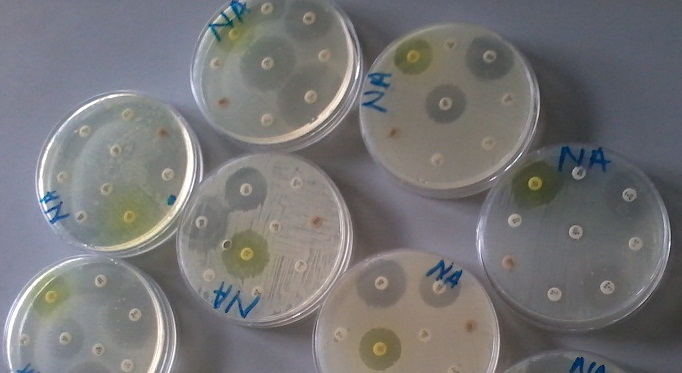Ceftazidime-imipenem antagonism test (CIAT) is one of the phenotypic confirmation tests that can be used to phenotypically confirm AmpC enzyme production in test bacteria isolates that showed reduced susceptibility or resistance to any of the tested antibiotics used in the screening test for AmpC enzyme production screening.
Therefore, AmpC enzyme production in the test organisms can also be evaluated using the ceftazidime-imipenem antagonism test (CIAT) for the detection and confirmation of the presence of inducible AmpC beta-lactamases in the test bacteria. CIAT should be performed using ceftazidime (30 µg) disk and imipenem disk (10 µg) as.
Ceftazidime disc and imipenem disk should be placed at a distance of 20 mm apart on Mueller-Hinton (MH) agar plate previously inoculated with a suspension of the test bacteria (adjusted to 0.5 McFarland turbidity standards) that showed reduced susceptibility to cefoxitin.
A cefoxitin disk (30 µg) should also be placed at a distance of 20 mm from the ceftazidime disk for comparison. All the MH agar test plates should be incubated at 37oC for 18-24 hrs. Antagonism indicated by a visible reduction in the inhibition zone around the ceftazidime disk adjacent to the imipenem or cefoxitin disk should phenotypically infer a positive inducible AmpC beta-lactamase production.
Brief note on AmpC enzymes
Chromosomal AmpC enzymes (which can also be called inducible AmpC enzymes) and plasmid-borne AmpC enzymes are the two main types of AmpC beta-lactamases that exist amongst bacteria especially in Gram negative organisms – in which these multidrug resistant enzymes are produced. AmpC enzymes are broad-spectrum beta-lactamase enzymes that are usually encoded on bacterial chromosome, and which are active on cephamycins (e.g. cefoxitin and cefotetan) and oxyimino-β-lactam agents.
They can also be plasmid encoded; and AmpC enzymes like other extended or expanded beta-lactamases such as ESBLs and MBLs confer on pathogenic Gram negative bacteria the exceptional ability to be resistant to a wide array of beta-lactam drugs and non-beta-lactams. AmpC beta-lactamases are bacterial enzymes that hydrolyze third-generation extended spectrum cephalosporins and cephamycins (e.g. cefoxitin), thus engendering antimicrobial resistance to these categories of antibiotics.
AmpC beta-lactamases are differentiated from extended spectrum beta-lactamases (ESBLs) by the ability of the former (i.e. AmpC enzymes) to hydrolyze cephamycins (e.g. cefoxitin) and their lack of inhibition by clavulanic acid. The expression of AmpC enzyme is typically inducible in several Enterobacteriaceae and other Gram negative bacteria including but not limited to Escherichia coli, Klebsiella species, Enterobacter species and Pseudomonas aeruginosa; and the production of this enzyme facilitates the emergence under antibiotic pressure of highly resistant but stable depressed mutants of the organisms.
And these highly resistant but stably depressed mutants of the organisms have the ability to hydrolyze extended spectrum cephalosporins and other beta-lactam agents even though they may still remain susceptible to the carbapenems (e.g. imipenem and meropenem). The genes that codes for the production of AmpC enzymes in bacteria are normally chromosomally-mediated. Plasmid-mediated AmpC enzyme production in bacteria is also possible amongst bacterial organisms through genetic transfer mechanisms such as conjugation and transduction
REFERENCE
Ejikeugwu Chika, Esimone Charles, Iroha Ifeanyichukwu,Adikwu Michael (2018).First Detection of FOX-1 AmpC β-lactamase gene expression among Escherichia coli isolated from abattoir samples in Abakaliki, Nigeria. Oman Medical Journal, 33(3):243-249.
Discover more from Microbiology Class
Subscribe to get the latest posts sent to your email.





